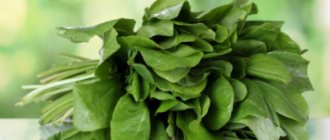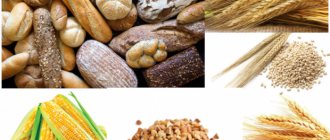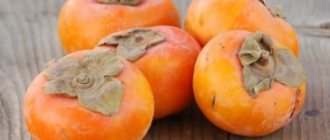The benefits of beets for baby nutrition
The root vegetable is usually valued precisely for its effect on the baby’s digestive system:
- Eliminates the development of constipation, with regular use in accordance with the permitted standards;
- Reduces flatulence;
- Normalizes intestinal motility.
Beets have a mild effect due to plant fibers or coarse fiber. It helps the growth of beneficial microflora that populates the intestines, which prevents the development of constipation and dysbiosis, which also leads to stool disorders.
Also, eating vegetables stimulates the formation of red blood cells, which has a beneficial effect on brain development. It will also relieve problems in the thyroid gland, if necessary, protect the liver and support its functioning.
Nutritional value
Beets are a low-calorie product, but they can increase appetite, which makes introducing them into the diet indispensable for those with small teeth. It is rich in fiber and carbohydrates, contains virtually no fat, and contains a small amount of protein.
Beets are rich in vitamins, including group B, necessary for the development of the nervous system, reducing nervous excitability, and supporting digestion. The root vegetable contains iron, which is easily absorbed by the child and reduces the risk of anemia. It contains calcium, magnesium, phosphorus and iodine.
Note! The vegetable contains antioxidants that will help strengthen the baby’s immunity and increase its resistance to various diseases. Pectin, which is part of beets, removes toxins from the body.
Beetroot for children Advantages
Beetroot is a very healthy vegetable
- 100 g of beets contains approximately 4 g of fiber, as well as potassium and magnesium, which explains its laxative effect.
- Beets contain the substance betaine, which belongs to the group of phospholipids, improves liver and brain function, and slows down aging.
- It contains organic nitro compounds that dilate blood vessels and increase endurance.
- Beets contain pectin, which removes harmful substances, toxins, and heavy metal salts from the body.
- It contains many vitamins and microelements.
Beets for children Disadvantages
- This vegetable, along with greens (parsley, dill, lettuce, kale, green onions) and watermelons, belongs to the group of vegetables with a high content of nitrates. It actively absorbs them from the soil and accumulates them. When consuming beets, especially in large quantities, there is a risk of nitrate poisoning. The first signs of such poisoning: nausea, vomiting, dizziness. Therefore, you need to choose environmentally friendly beets for your child and give them in moderation.
- Beetroot often causes allergies, so it should be introduced into a child’s diet with caution.
- It has a pronounced laxative effect, and if it is in excess, diarrhea may develop. Therefore, the total amount of beets in the diet is limited.
Conclusion
Beets are good for a child if they are environmentally friendly beets in quantities appropriate to the child’s age.
The question: can children eat beets is of most concern to those parents whose children are prone to constipation. The laxative properties of beets are widely known. And it is this that is mainly relevant for children. Its other beneficial properties are more important for adults.
In children's nutrition, beets can be successfully used as a laxative to normalize stool. It is quite possible to give beets to healthy children in the amount recommended by age.
How to give beets to babies
At what age can you give your child a fresh apple?
Up to a year, it is better to give beets to babies after heat treatment. It can be stewed, boiled or baked. This, of course, will deprive the vegetable of some useful substances and vitamins, but will also get rid of nitrates, to which the baby’s digestive system may react poorly.
Juice
When you can give your child beetroot juice depends on how many months the root vegetable itself was introduced into complementary foods. Only when the baby assimilates the vegetable and gets used to it, can you move on to juice. There is no need to rush to add it to the diet; it is even better to give it to a one-year-old child. Not only because it is prepared from raw vegetables. The juice itself has a specific taste and is difficult to digest. You need to dilute it with water or other juice, such as apple juice. Its use can lead to irritation of the mucous membrane of the digestive tract.
Beet juice
Note! Beetroot juice should be no more than a third of the total volume of the drink offered to the baby.
No need to be upset if your baby doesn't like it. Children are more willing to eat pureed boiled vegetables, the benefits of which are much higher.
Boiled
The most popular method of heat treatment is cooking. You need to use as little water as possible so that it lightly covers the root crop. This way, boiled beets will lose fewer nutrients.
other methods
Beetroot for babies can also be stewed or baked. It is washed and peeled in advance. When baking, the root vegetable is cut into small slices and placed in the oven, lightly sprinkled with oil. Before stewing, raw beets are grated on a coarse grater and placed in a frying pan along with other vegetables familiar to the baby. There is no need to close the lid; nitrates come out of the vegetable along with the steam. You can soak it in cool water for half an hour in advance.
Note! Beets are not given to babies separately, so they can be cooked with other products.
To give the finished dish the desired consistency, it is most convenient to use a blender. You can always add water if necessary.
Recipe for delicious baby beetroot soup
1. Potatoes and beets are soaked in cold water for at least 1 hour and boiled with the skins on. Then they cool and peel, cutting off more of the root and tail from the beets.
2. Potatoes are cut into cubes.
3. Grate the beets.
4. Finely chop the eggs, garlic and herbs.
5. Add beets, potatoes, and bay leaves to boiling water. After it boils, add eggs, herbs and garlic. Bring to a boil and remove from heat.
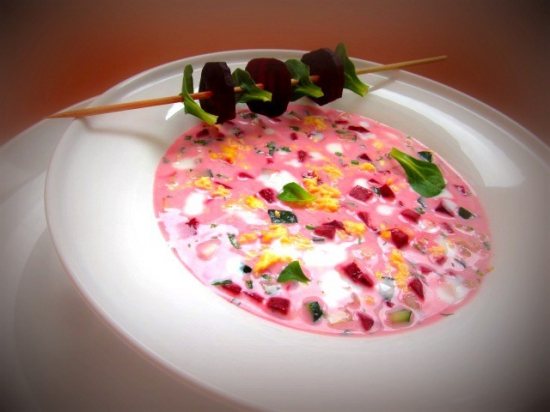
Since beetroot soup is for children, it can be decorated with figures of boiled vegetables. If you set aside a few beet slices in advance, you can use a cookie cutter to cut out flowers or hearts or animal figures. The molds are placed on the rim of the plate, and beetroot soup is poured into the middle. From 1.5 years old, the first dish can be seasoned with sour cream.
Market Analytics
- Black Lives Matter movement: reaction and consequences for the beauty industry
- COVID-19 is changing the rules of the game in the cosmetics market
- Beauty of the future: cosmetic innovations 2020
Convenient search for beauty salons on our website
Beauty salons in Moscow Beauty salons in St. Petersburg Beauty salons in Ekaterinburg Beauty salons in Novosibirsk
Latest blog posts on our website
- Naturecream / Apricot kernel oil for face
- Naturecream / MATRIXYL3000 - the best skin elasticity stimulator
- Naturecream / SPF in Natural Oils
- Naturecream / Geranium (Pelargonium) oil for skin health and beauty
- Prostye-sovety / Save on a beauty salon: procedures that can be done at home
- Naturecream / Growth Factor - brings back youth?
- Oksana-Lezina / 3 effective abdominal exercises from a fitness instructor for beginners
- Prostye-sovety / Making perfect curls at home
- Prostye-sovety / Which hair removal method to choose
- Naturecream / Wrinkles Puppets
Latest forum topics on our website
- Natalya / How to properly make a gelatin mask?
- Mrs._Smith / Badly sunburned! What to do?((
- Ice / Is it necessary to combine fitness classes with a diet?
- Antonova / What can be used for hair loss?
- Radio operatorKat / Who was on a protein diet?
Other articles in this section
| Solyanka with pearl barley You can use pearl barley as an additional product when preparing solyanka. First courses with barley always have a special taste. And when combined with cold cuts, the taste is amazing. |
| Bulgarian okroshka “Tator” Cold summer soup can be prepared according to the Bulgarian recipe. Thanks to the inclusion of fresh vegetables, full-fat kefir and special spices, this first dish acquires an unusual refreshing taste, which makes it perfect for consumption on hot summer days. |
| Solyanka with sausage If the classic version of solyanka involves adding at least 5 types of smoked and boiled delicacies, then an everyday lunch can be prepared by adding a couple of varieties of sausage. Solyanka with sausage for every day is simple, but that doesn’t make it any less tasty. |
| Rassolnik with millet and salted tomatoes You can prepare rassolnik with different cereals. We offer an option for preparing the first course with millet. The quantity of products is designed for 6-7 persons. |
| Ukrainian borscht with meat We present one of the oldest borscht recipes. It is believed that real Ukrainian borscht is made from pork. The best choice is brisket. Borscht with pork is quite rich, but despite this, it can be included in the menu for some diets. Preparation takes more than 3 hours. |
| Pea soup with pork It is generally accepted that pea soup first appeared in Ancient Greece. Today this first dish is included in the cuisines of different nations; it is impossible to attribute it to a specific culture. Pea soup with pork is an ideal option for eating during the cold season, as it is a rich and healthy dish. |
| Gazpacho with beans Gazpacho soup from Spain is a popular dish among modern housewives. Along with okroshka, it is prepared in the summer heat or a hot recipe is used, cooked with meat to make the dish more nutritious and satisfying. Gazpacho soup is so easy to prepare that you can easily do without clear instructions with photographs - everything is extremely simple. |
| Gazpacho Soup with Cheese Spanish gazpacho soup can be made with delicious cheese balls made from goat cheese. In general, the recipe for the first course is no different from already familiar cooking recipes, but the savory balls add personality to it. |
| Solyanka in a multicooker After feasts, when a lot of leftover meat delicacies, such as smoked brisket, balyk, sausages, different types of sausages, accumulate in the refrigerator, it’s time to prepare a delicious homemade meat solyanka. It is believed that the more types of meat products are added, the tastier this first course turns out. |
| Classic okroshka with kvass Okroshka with kvass is a classic version of everyone’s favorite summer first course. Who invented okroshka? Since the dish is ancient, there are several hypotheses. The most common one is that barge haulers on the Volga were fed okroshka. In the morning they gave us hearty porridge to give us more strength, and for lunch (so we didn’t waste too much) dried roach soaked in kvass. |
When to introduce beets into complementary foods
At what age can you give your child honey?
The time at which beets are introduced into complementary foods depends on the timing of the baby’s introduction to adult food. There are a few important rules to remember:
- For breastfed children, products are added to the diet after 6 months. Previously, this was not necessary; mother’s milk gives the growing body everything it needs. A 6-month-old baby is already ready to be introduced to adult food; breastfeeding alone is no longer enough for him to fully grow and develop;
- Artificial babies receive complementary feeding a little earlier - at 4-4.5 months;
- The first vegetables to appear in the diet are zucchini, broccoli, and cauliflower. After some time, pumpkin, potatoes and carrots are introduced;
- Next, dairy-free porridge is added. It is recommended to start with corn, buckwheat and oatmeal.
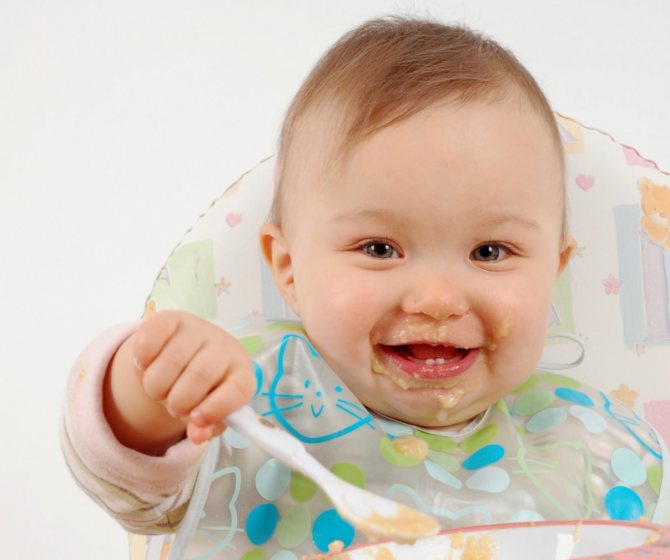
Porridge in complementary foods
Later, at the age of 8-9 months, you can give the child beets, when he gets acquainted with new products and gets used to them. If your baby is prone to developing allergies, including to foods, you should avoid beets for up to a year. Despite the invaluable benefits, its use can indeed lead to a negative reaction.
Earlier entry is permitted according to doctor's indications. If, for example, a baby has chronic constipation, and massage and gymnastics do not help him cope with it. Enemas and other means that stimulate intestinal function will not benefit the child, but the gentle action of the root vegetable can alleviate the situation.
How to cook beets
When choosing a root vegetable for preparing a dish, a baby should be approached responsibly:
- It is preferable to use small vegetables. Beets tend to absorb substances used for fertilizer from the soil. The larger the size of the fruit, the higher the likelihood of containing pesticides and other harmful additives;
- The color should be dark red, bright, without white streaks.
At what age can a child be given pork?
It is better to take vegetables from your own garden or from trusted farms that guarantee the quality of the product.
The beets need to be washed thoroughly; you can use a sponge to completely remove dirt and soil. Then cut off the top in the place where the tops were. This is where the most nitrates accumulate. There is no need to cut off the skin; underneath it contains a lot of nutrients, so it is better to carefully remove it after cooking.
Pour water into the pan so that it slightly covers the vegetable and place over medium heat. As soon as the beets can be pierced freely with a knife to the middle, they are ready.
Note! To minimize the amount of harmful substances, you can boil the vegetable for 10-15 minutes, then change the water and return the container to the fire.
Cooking time depends on the age of the root vegetable. Young vegetables are ready in 30-40 minutes, and the peel is removed from them without effort and even without a knife. Usually it takes 1-1.5 hours.
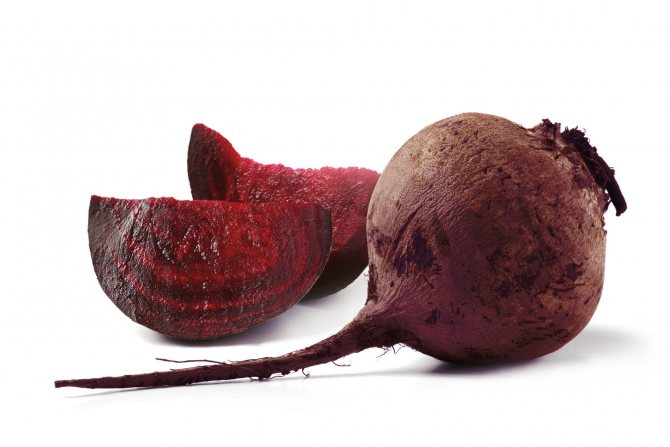
Boiled beets
After the beets are cooked, they need to be cooled, peeled and chopped. The blender is convenient to use. If the puree seems too thick, you can add a little water.
We must remember! Beets must be combined with other products; they are not recommended to be given to infants separately, especially as a first complementary food.
The juice is prepared from the raw root vegetable. You need to clean it and use a juicer. If it is not there, then you can grate the vegetable and then squeeze it out using gauze. Be sure to dilute with boiled water and only then offer a drop to the baby.
Norms for feeding beets for infants
Beetroot can be introduced into complementary foods for a child when he has tried green vegetables and become familiar with potatoes and carrots. If the baby has not experienced allergic reactions, then it’s time to think about expanding the diet. It is better to forget about beets, at least until a year, if the baby has a bowel disorder, in particular, he is prone to diarrhea. The root vegetable will only aggravate the situation by increasing intestinal motility. Therefore, such complementary foods are more suitable for babies suffering from constipation.
You need to remember the rules for introducing any new product:
- The baby should be healthy, alert and active. It is advisable that he has not recently suffered infectious diseases and has not participated in vaccination;
- The first portion should not exceed half a teaspoon. Beets need to be mixed with another product. However, it should not exceed 30% of the total volume of the dish;
- Be sure to give your baby a vegetable in the first half of the day, this is necessary in case of an allergic reaction, in order to provide timely assistance.
Complementary feeding for a baby is a little stressful. Therefore, it cannot be superimposed on the infant’s other experiences. It is worth protecting his fragile nervous system.
How often to give
For children under one year of age, it is not recommended to give beets more than once a week. The same applies to juice from root vegetables. Although beets are useful, and in some cases irreplaceable, they are often not worth eating for a child under one year old.
Quantity
For the first time, the baby will try half a teaspoon of beetroot puree added to other products. So, on the second day, when he tastes it, you can increase the portion. This is done only if the child does not develop rashes or other negative reactions. If they are present, you should immediately discontinue the product and consult a doctor. Self-medication, especially for children under one year old, is dangerous and can lead to irreparable consequences.
Usually, on the 7th day of complementary feeding with a new product, its volume is adjusted to the permitted norm. For beets it is 25-30 grams. Be sure to remember that it should be exactly a third of the dish, no more.
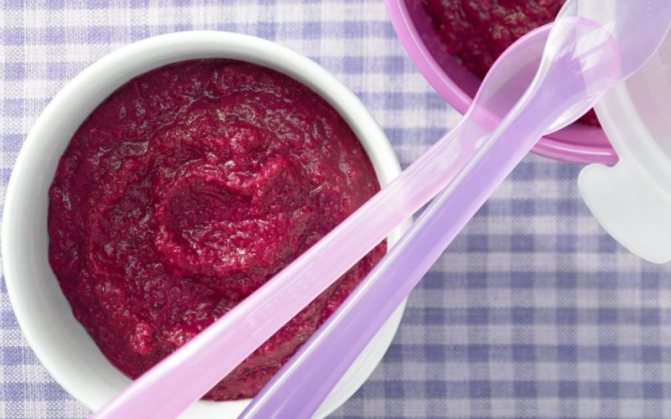
Beet puree
After a year, the baby will already try soups, salads, and as for purees, it is better for infants to limit themselves to thirty grams a day, once a week. You should not give your baby beets as much as he eats, this can negatively affect digestion.
Note! After 12 months, the serving size can be increased to 50 grams. Up to 7 years of age, it is not recommended to offer a child more than 100 grams of product per day.
What can be combined with
Beets go well with vegetables and fruits. So it is added to potatoes, carrots, and zucchini. You can make puree with an apple, diluting it with water so that it is not so thick. It is not recommended to add salt to dishes or add sugar to them until one is a year old. You can add a few drops of vegetable oil.
When the baby begins to cope with pieces, you can gradually transfer him to the common table. Many children love borscht, which is prepared without cabbage if the little one doesn’t like it too much. If you are going to give soup with beef, then you need to boil it longer so that it becomes soft and the baby can handle it. This is provided that it is already in the diet.
Beetroot puree can also be combined with various porridges. It can be added to barley, pearl barley, wheat, rice and buckwheat. In this case, they need to be boiled in water. This will diversify the taste of dishes familiar to the baby and give them a zest.
When adding beetroot puree to other products, it is necessary that they are well known to the baby. Only when he has mastered them separately is it permissible to mix them.
The famous children's doctor Komarovsky strongly recommends not to force-feed children, but to only introduce them to a variety of foods and flavor combinations until they are one year old. The child should be interested in food and eat it with pleasure. The basis of the diet during the first 12 months is breast milk or an adapted formula.
The benefits and harms of beet juice for a child
Beetroot juice has the same healing properties as the root vegetable:
- contains many vitamins, which contributes to the normal physical development of the child;
- contains iodine and iron , which prevents the development of anemia;
- used to prevent constipation;
- strengthens blood vessels;
- reduces nervous excitability;
- lowers blood pressure;
- normalizes liver function;
- has anti-inflammatory properties, promotes wound healing;
- removes cholesterol.
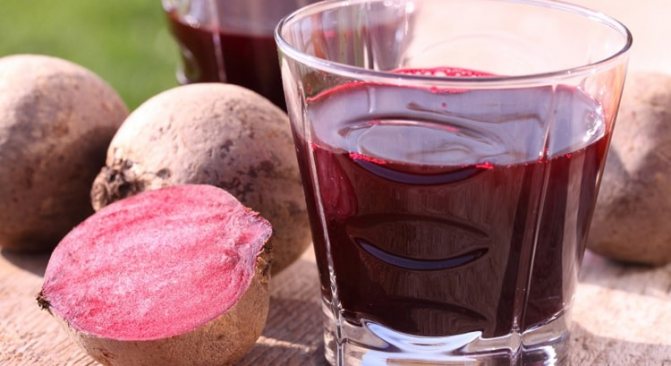
In addition to its beneficial properties, beet juice also has contraindications:
- Poor-quality producers can use nitrates and various harmful additives in the soil to increase productivity. Beets actively collect these substances. Drinking the juice of such vegetables can negatively affect kidney function.
- The property of lowering blood pressure has a good effect on the health of adults with problems of the cardiovascular system. But this feature of beets is not beneficial for children.
- Drinking beet juice is not recommended for children prone to diarrhea.
Possible problems when feeding beets
Beets are considered an allergenic product, so they are not recommended to be introduced into the diet first and generally added to dishes if the baby is prone to skin rashes or diarrhea.
When eating root vegetables, a baby may experience the following undesirable symptoms:
- Rash, mainly on the cheeks, may be itchy;
- Nausea or vomiting, frequent regurgitation;
- Watery eyes, redness of the eyes;
- Sneezing and nasal congestion;
- Decreased appetite;
- Diarrhea;
- Quincke's edema.
You can be poisoned by beets if you buy them from an unverified seller. When it contains a lot of nitrates and pesticides, the baby’s body can react to them. However, proper heat treatment will rid the product of them, so its consumption becomes safe. It is better not to make juice from beets purchased in an unfamiliar place.
Note! In young children, eating root vegetables can lead to a decrease in blood pressure, so it is necessary to closely monitor the child’s well-being.
In any case, if the baby’s behavior changes, or symptoms of poisoning or allergies appear, a doctor’s consultation is required. Only a specialist will be able to prescribe the correct treatment, relieving the symptoms and alleviating the baby’s condition. If the baby begins to choke and there is a suspicion of swelling of the mucous membranes, you should immediately call an ambulance.
Be sure to remove beets from complementary foods and forget about their return for a while. Perhaps the child will outgrow it and after 1.5 years will normally accept the healthy root vegetable.
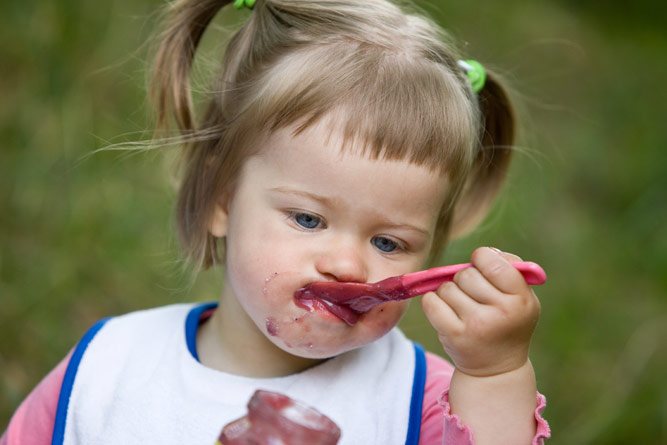
An older child eats beets
To understand when you can give beets to your baby, you need to know how the vegetable is digested and how to prepare it correctly. It is not recommended to introduce it into complementary foods first; it can lead to digestive problems and provoke allergies. Following all the recommendations will help you avoid problems, and beets in the diet will improve not only digestion, but also strengthen the baby’s immune system and nervous system. There are many dishes that can be prepared from healthy root vegetables to the delight of not only children, but also adults.


